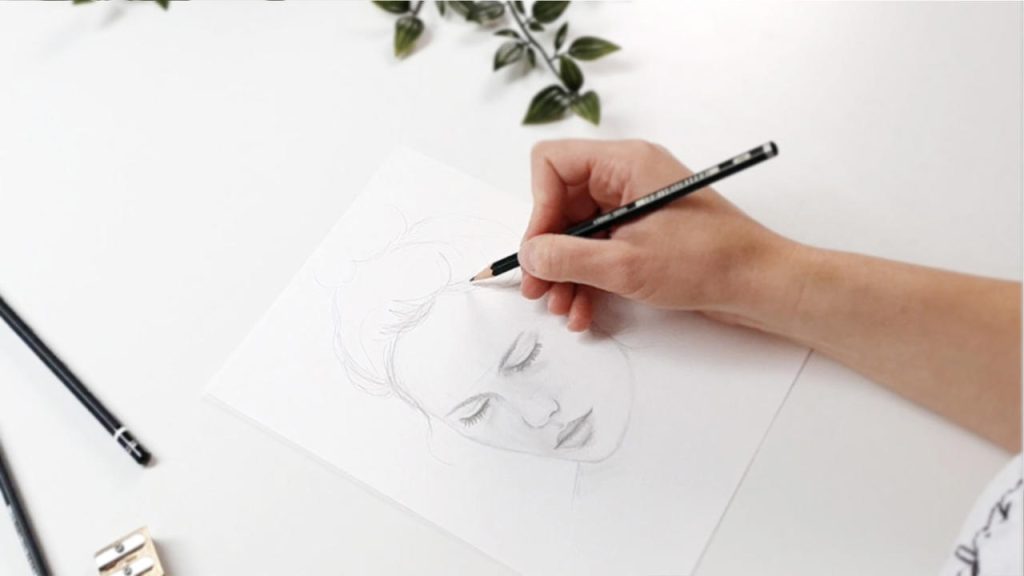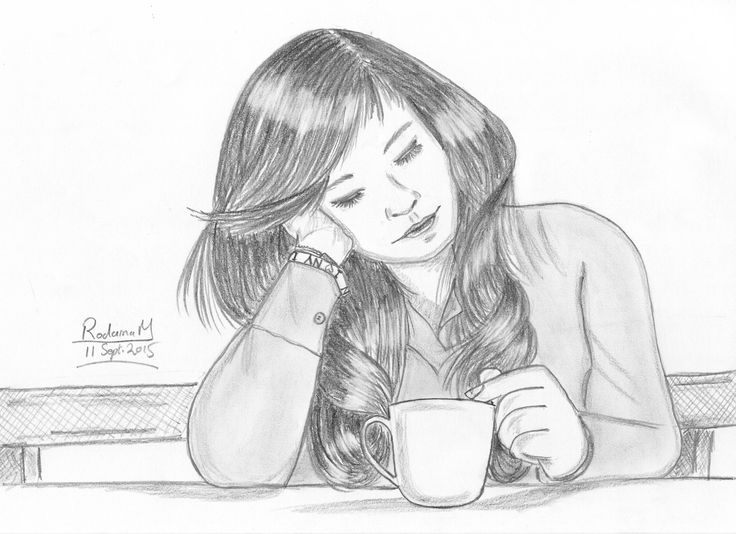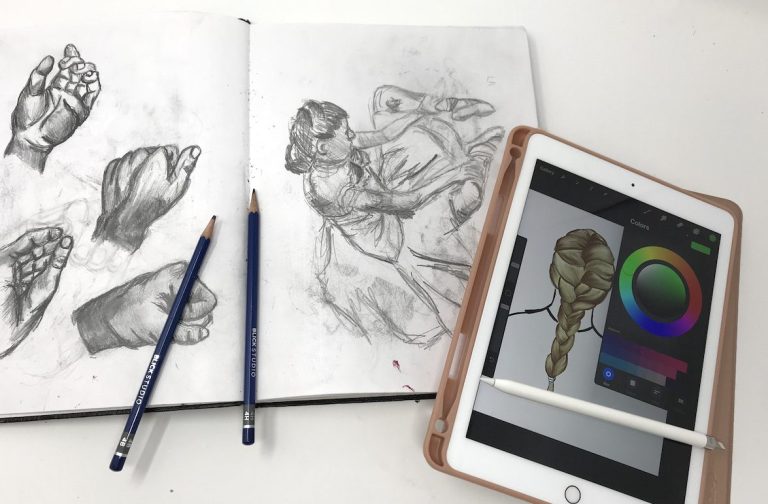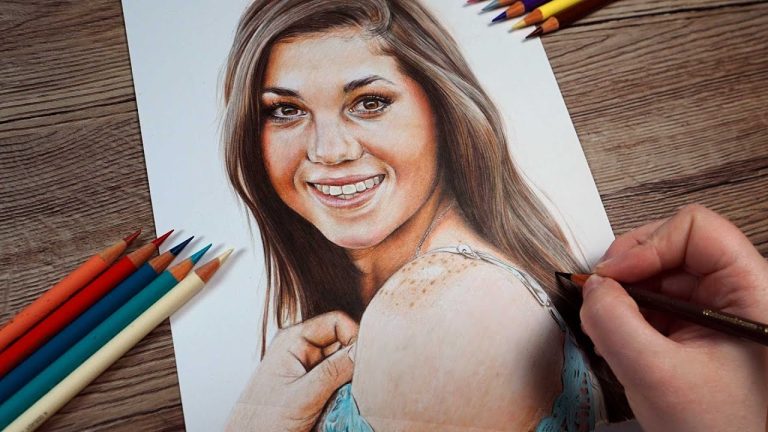Drawing images is a captivating and expressive form of art that allows individuals to convey their creativity visually. Whether using traditional mediums such as pencils and paper or embracing the digital realm with graphics tablets and software, the process begins with a blank canvas waiting to be transformed. Artists often start by mastering the fundamentals, honing their skills in capturing basic shapes and understanding anatomy. The play of light and shadow becomes a crucial aspect,

A Creative Journey with Pencil and Paper
the humble pencil and paper – tools that have sparked countless creative journeys throughout history. In their unassuming simplicity, they offer a vast canvas for imagination to run wild, emotions to pour forth, and stories to unfurl. So, let’s embark on a creative journey with these trusty companions, shall we?
The First Stroke:
It all begins with a hesitant mark, a tentative line whispering across the white expanse. Maybe it’s a single, graceful curve, the birth of a leaf fluttering in the breeze. Or perhaps it’s a bold, confident stroke, declaring the presence of a towering mountain range. Each mark holds a choice, a direction, a whispered promise of what’s to come.
Embracing the Imperfect:
The beauty of pencil and paper lies in their forgiving nature. Erase, retrace, experiment – there’s no room for judgment, only possibilities. Let smudges become ethereal clouds, stray lines morph into dancing flames. Embrace the happy accidents, the unexpected turns, for they can often lead to the most captivating creations.
Finding Your Voice:
As you move across the paper, your unique voice begins to emerge. The pressure of your grip, the dance of your hand, the whispers of your soul – all leave their mark. Are you drawn to the delicate intricacies of nature? Or do you find joy in the stark lines of urban landscapes? Perhaps emotions whisper stories onto the page, translating joy into swirling shapes and sorrow into rain-drenched streets.
Beyond the Lines:
The world within your Drawing images doesn’t have to be confined by its borders. Let imagination bleed into reality, blurring the lines between paper and world. Add textures, fragrances, whispers of sound – breathe life into your creations. Close your eyes, step into your drawing, and feel the rustle of leaves, the warmth of sunlight, the heartbeat of your story.
A Shared Symphony:
The magic of pencil and paper extends beyond the solitary act of creation. Share your journey, invite others to step into your world. Show your sketches to a trusted friend, let a loved one trace your lines, or gift your creations to spread joy. In the shared appreciation of art, a silent symphony of emotions connects souls across distances.
The Journey Never Ends:
With each stroke, each new page, the creative journey deepens. There are mountains to climb, oceans to cross, dreams to Drawing images into existence. The pencil and paper, your loyal companions, will lead the way. So, open your heart, grab your tools, and step onto the blank canvas of possibility.

Mastering the Art of Detailed Drawings
the quest for detail! It’s a journey that Drawing images artists in with its promise of realism, depth, and breathtaking beauty. But mastering the art of detailed drawings takes dedication, practice, and the right tools and techniques. Buckle up, because we’re diving deep into the world of intricate lines and mesmerizing textures!
Building a Strong Foundation:
- Understanding Anatomy and Perspective: Whether you’re drawing landscapes, portraits, or fantastical creatures, knowing how things are shaped and how they respond to light and space is crucial. Invest in anatomy books, perspective guides, and practice Drawing images basic shapes and forms from different angles.
- Refine your Observational Skills: Train your eye to see the subtleties. Notice how light falls on an object, how textures shift, and how edges transition from sharp to soft. Carry a sketchbook and capture these details from life, practicing quick studies and longer observational drawings.
- Mastering Pencil Techniques: Learn how to control your pencil pressure for varying shades and line weights. Experiment with hatching, cross-hatching, stippling, and other shading techniques to create realistic textures and depth.
Delving into Details:
- Start Big, Go Small: Begin your drawing with loose, gestural strokes to capture the overall form. Then, gradually zoom in, adding layers of detail bit by bit. Focus on specific areas, like eyes, textures, or intricate patterns, paying meticulous attention to each line and shadow.
- Reference is Your Friend: Don’t shy away from using high-quality photographs or other visual references. They can guide you in accurately capturing details you might miss with your naked eye. But remember, references are tools, not crutches. Use them to learn, not copy.
- Embrace Patience and Persistence: Detailed drawings take time. Don’t get discouraged if progress feels slow. Celebrate each accomplishment, even small ones, and trust that with consistent practice, your attention to detail will grow.
Tools of the Trade:
- Invest in Quality Pencils: A good set of drawing pencils with varying grades will give you the control and range you need. Experiment with different lead types and sharpen them regularly for crisp lines.
- Explore Other Mediums: Don’t limit yourself to just pencil! Inks, charcoal, colored pencils, and even mixed media can offer unique avenues for adding detail and texture to your drawings.
- Find the Right Paper: Choose paper with a smooth surface that can handle fine lines and delicate shading. Experiment with different textures and weights to find one that suits your style and medium.
Beyond the Techniques:
- Develop your Artistic Vision: What story do you want your detailed drawings to tell? Define your artistic style and focus on elements that enhance your unique voice. Experiment with composition, lighting, and mood to create impactful pieces.
- Seek Inspiration: Immerse yourself in the work of other artists who excel at detailed drawings. Study their techniques, compositions, and subject matter, but always filter their influence through your own creative lens.

Navigating the World of Digital Drawing
Welcome to the vibrant realm of digital drawing! It’s a world overflowing with creative possibilities, where brushes dance across virtual canvases and imagination can be brought to life with endless shades and textures. But navigating this wonderland can be daunting for newbies, so fear not, adventurer! Let’s dive into the fundamentals and set you on your digital art journey.
Choosing Your Weapon:
- Software Selection: The digital canvas comes in many forms. Popular options like Photoshop, Procreate, and Clip Studio Paint offer wide-ranging toolsets and features. Consider your budget, artistic goals, and device compatibility when choosing your companion.
- Tablet Time: Ditch the mouse and embrace the freedom of a drawing tablet! Wacom, XP-Pen, and Huion are some established brands, offering pressure sensitivity and pen tilt for a natural drawing experience.
- Hardware Harmony: Ensure your computer can handle the software and brush textures you crave. Investing in a dedicated graphics card can significantly boost performance and smooth out your artistic flow.
Learning the Language:
- Brush Basics: Master the core tools – line art brushes, textured brushes, blending brushes, and erasers. Learn how to adjust their properties like size, opacity, and pressure to create diverse effects.
- Coloring Theory: Dive into the vibrant world of color! Understand how colors interact, create harmonious palettes, and experiment with shading and lighting techniques to imbue your creations with depth and emotion.
Embracing the Journey:
- Practice Makes Perfect: Just like traditional art, digital drawing requires dedication and practice. Start with simple exercises, play with different brushes and techniques, and don’t be afraid to make mistakes – they’re stepping stones to growth!
- Inspiration Everywhere: Seek inspiration from other digital artists, delve into online tutorials, and experiment with existing brush packs and assets. Find your artistic style and voice, and let your unique vision shine through!
- Community Connection: The digital art world is abuzz with talented individuals and supportive communities. Join online forums, participate in challenges, and share your work for feedback and encouragement.
Beyond the Canvas:
- Going Public: Share your masterpieces on social media platforms like Instagram, ArtStation, or DeviantArt. Connect with other artists, build an audience, and even explore online marketplaces to sell your creations.
- Printing is Powerful: Don’t let your art stay trapped in the digital realm! Turn your creations into physical prints, stickers, or even merchandise to share your art with the world in a tangible way.
- Never Stop Growing: The beauty of digital art is its constant evolution. Stay updated with new software features, explore emerging tools and technologies, and keep learning to push your artistic boundaries and unlock new creative possibilities.

Exploring Realism in Drawing
realism in drawing! It’s the captivating pursuit of capturing the world around us with such precision and detail that it seems to leap off the page. But fear not, aspiring master of realism, for the path towards creating lifelike drawings is both challenging and rewarding. Let’s embark on this artistic journey together, exploring the tools, techniques, and mindset that will guide you towards drawing stunningly realistic works.
Building a Strong Foundation:
- Anatomy and Perspective: Knowledge is power! Understanding the underlying structure of your subject, whether it’s a human figure, an animal, or a complex object, is crucial for accurate representation. Invest in anatomy books, study perspective guides, and practice drawing basic forms from different angles.
- Mastering Observational Skills: Train your eye to be a meticulous detective. Notice subtle variations in shape, texture, and light. Carry a sketchbook and capture quick studies from life, focusing on details like shadows, highlights, and the interplay of light and shadow.
- Refine your Pencil Techniques: Learn to control your pencil pressure to achieve a wide range of values and line weights. Experiment with hatching, cross-hatching, stippling, and other shading techniques to create realistic textures and depth.
The Art of Detail:
- Start Big, Go Small: Begin your drawing with loose gestures to capture the overall form. Then, zoom in gradually, adding layers of detail bit by bit. Focus on specific areas like eyes, textures, or intricate patterns, paying meticulous attention to each line and shadow.
- Reference is Your Friend: Don’t shy away from using high-quality photographs or live models as reference. They can guide you in accurately capturing details you might miss with your naked eye. However, remember to use references as tools, not crutches. Learn from them, but allow your artistic voice to shine through.
- Patience and Persistence: Mastering realism takes time and dedication. Don’t get discouraged if progress feels slow. Celebrate each achievement, however small, and trust that with consistent practice, your accuracy and attention to detail will blossom.
Beyond the Technical:
- Light and Shadow: Light is the sculptor of form, and shadow its accomplice. Understand how light falls on your subject, creating highlights, mid-tones, and shadows. Master techniques like chiaroscuro to create depth and drama in your drawings.
- Composition and Focal Point: Guide the viewer’s eye through your artwork with intentional composition. Create a focal point and utilize leading lines to draw attention to specific elements.

Mastering the Play of Light and Shadow
the dance of light and shadow! It’s the heart of visual storytelling, breathing life into your drawings and transforming flat forms into captivating realms of depth and emotion. Mastering this intricate play is a journey both demanding and rewarding, one that will elevate your art to new heights. So, let’s delve into the secrets of light and shadow, equipping you with the knowledge and techniques to become a true maestro of visual drama.
Understanding the Luminous Language:
- Light as Sculptor: Imagine light as a spotlight, carving out shapes and revealing textures. Study how it falls on your subject, creating highlights, mid-tones, and shadows. Understand how different angles and intensities of light affect shapes and edges.
- Shadows as Partners: Don’t fear the darkness! Shadows define form, create depth, and add intrigue. Learn to differentiate between core shadows, cast shadows, and reflected light. Understand how shadows soften with distance and blend with ambient light.
- Color and Light’s Tango: Light isn’t just white! Observe how it interacts with different colors, altering their hues and values. Warm light casts cool shadows, while cool light throws warm shadows. Use color theory to enhance the interplay of light and shadow.
Capturing the Dance on Paper:
- Value, Your Guiding Star: Learn to see your subject in terms of values, from the brightest highlights to the deepest shadows. A good value study lays the foundation for nuanced shading and impactful contrast.
- Blending with Confidence: Smooth transitions between light and shadow are key to realism. Master blending techniques like hatching, cross-hatching, and stippling to create seamless gradients and avoid harsh lines.
Beyond the Technical:
- Mood and Atmosphere: Light and shadow are powerful storytelling tools. Use them to set the mood, evoke emotions, and guide the viewer’s eye. Dramatic chiaroscuro creates suspense, while soft, diffused light conveys tranquility.
- Compositional Harmony: Place your highlights and shadows strategically to create a visually pleasing composition. Use light to draw attention to focal points and guide the viewer through your scene.
- From Observation to Imagination: Learn from real-life light and shadow, but don’t be afraid to let your imagination take flight. Create dramatic lighting scenarios, play with artificial light sources, and use light and shadow to tell your own unique stories.
Tools and Techniques:
- The Right Canvas: Choose paper with a good tooth that allows for smooth blending and layering. Experiment with different textures and colors to find one that complements your light and shadow play.
- Mediums of Expression: Charcoal is a master of shadows, blending with ease and creating dramatic effects. Pencils offer precision and control for detailed highlights. Explore mixed media to add richness and textural depth.
- Digital Light and Shadow: Digital tools like layer masks and blending brushes can accelerate your workflow and offer non-destructive experimentation. Learn how to manipulate light and shadow digitally to create stunning effects.
Growing Your Skills as a Visual Creator
The journey of a visual creator is one of constant growth and evolution, a thrilling quest to hone your skills and unleash your artistic voice. Whether you’re a seasoned artist or just embarking on your creative adventure, there’s always room to expand your horizons and refine your craft. So, grab your metaphorical paintbrush, and let’s explore some inspiring avenues for fostering your growth as a visual creator:
Embrace Experimentation:
- Step outside your comfort zone: Don’t be afraid to try new mediums, techniques, and subjects. Explore collage, digital art, sculpture, or even performance art. Push your boundaries and discover hidden talents you never knew you had.
- Challenge yourself with creative prompts: Participate in art challenges, online prompts, or self-imposed projects. Embrace limitations and constraints as catalysts for creativity. You might surprise yourself with what you can achieve.
- Collaborate with other artists: Teaming up with creators from different disciplines can spark fresh ideas and cross-pollinate your artistic approaches. Learn from each other’s expertise and challenge each other’s perspectives.
Deepen Your Knowledge:
- Formal education: Consider enrolling in art classes, workshops, or online courses. Structured learning can provide valuable foundations in technique, theory, and critical thinking.
- Immerse yourself in art history: Learn from the masters! Spend time studying the works of artists you admire, understanding their styles, techniques, and the artistic movements that shaped them.
- Become a student of observation: Train your eye to see the world through an artistic lens. Pay attention to details, light and shadow, composition, and color relationships. Carry a sketchbook and capture the beauty around you in quick studies.
Sharpen Your Technical Skills:
- Master the fundamentals: Whether it’s drawing principles, color theory, or composition, having a solid grasp of the basics will serve you well in any artistic endeavor. Practice regularly and hone your technical skills until they become second nature.
- Embrace technology: Explore digital tools like drawing tablets, photo editing software, and 3D modeling programs. These technologies can expand your creative possibilities and streamline your workflow.
- Seek feedback and critiques: Share your work with trusted friends, mentors, or online communities. Constructive criticism can help you identify areas for improvement and refine your artistic voice.
Build Your Artistic Voice:
- Develop your artistic vision: What makes your art unique? What stories do you want to tell? Define your style, find your artistic signature, and let it shine through in your work.
- Connect with your audience: Explore who your art resonates with. Share your work online, participate in artist communities, and engage with your audience. Connecting with others can spark inspiration and provide valuable feedback.
- Stay inspired: Feed your creative fire! Visit museums and galleries, watch inspiring films, read poetry, and immerse yourself in music. Be an active consumer of art and let it fuel your own creative journey.
The Narrative Power of Drawing
The humble pencil and canvas, or the sleek tablet and stylus, they all offer a gateway to a hidden superpower: the narrative power of drawing. It’s not just about capturing static images; it’s about weaving stories, evoking emotions, and transporting viewers to other worlds, all with a few deft strokes.
So, how does drawing wield this magic? Here are some key ingredients:
Visual Storytelling: Drawings don’t have the luxury of words, but they speak volumes through composition, action lines, expressions, and even empty space. A character’s tilted head can convey uncertainty, a lone figure in a vast landscape evokes solitude, and a dynamic chase scene sparks our adrenaline. Every line and shadow becomes a narrative thread, weaving a tapestry of emotions and experiences.
Emotional Resonance: Faces are powerful tools in a drawer’s arsenal. A tear rolling down a cheek, a furrowed brow, a mischievous grin – these simple details tap into universal emotions, connecting viewers to the characters and their stories. Drawings can make us laugh, cry, empathize, and rage, all without uttering a single word.
World-Building: From sprawling fantasy landscapes to gritty urban alleys, drawings have the power to create entire universes. Intricate details add layers of believability, while strategic use of light and shadow can evoke specific moods and atmospheres. We, the viewers, become explorers, stepping into these worlds and losing ourselves in their magic.
The Power of Suggestion: Drawings don’t need to show everything to tell a story. A half-seen figure in a darkened doorway, a trail of blood leading into the unknown, these suggestive elements spark our imagination. We become active participants in the narrative, filling in the blanks and constructing our own interpretations, making the experience all the more personal and impactful.
Beyond Words: Sometimes, emotions, experiences, and abstract concepts defy explanation with words. Drawings offer a visual language for these intangible things. A swirling vortex can represent despair, a burst of light can symbolize hope, and a fragmented image can capture the chaos of a troubled mind. Drawings speak where words fail, offering a raw and authentic expression of inner landscapes.
Of course, mastering this narrative power takes practice and dedication. But the beauty lies in the journey itself. Experiment with different styles, explore light and shadow, study human emotions, and most importantly, let your imagination run wild. Remember, even the simplest lines can weave tales that resonate, sparking wonder, empathy, and endless possibilities.
Frequently Asked Questions (FAQs)
- Start with simple shapes: Begin by sketching basic shapes like circles, ovals, and rectangles to represent the head, torso, and limbs. This will help you build a foundation for your drawing before adding details.
- Pay attention to proportions: The proportions of a girl’s body are generally different from those of a boy. For example, the head is typically larger in proportion to the body, and the waist is narrower than the hips.
- Oversexualization: Avoid drawing girls in overtly suggestive poses or clothing. Focus on capturing their personality and individuality rather than their physical attributes.
- Clichés and stereotypes: Don’t fall into clichés like damsels in distress or overly bubbly princesses. Be creative and explore diverse representations of girls.
- Art books and tutorials: There are many great books and online tutorials available that can teach you how to draw girls in different styles. Look for resources specifically focused on female figure drawing or character design.
- Online communities: Join online communities or forums for artists who draw girls. This is a great way to get feedback on your work, learn from others, and stay inspired.
Related posts:
- Girl Drawing Easy : Benefits of Girl Drawing
- Landscape Drawing
- Oil Pastel Drawing : Mastering the Art of Oil Pastel
- Santa Claus Drawing : Tips for Drawing
- Save Water Drawing : How Art Inspires a Water-Wise Future
- Simple Drawings : Finding Beauty in Basic Lines
- Tree Drawing : A Beginner’s Guide to Drawing Trees
- Drawing Colour




















